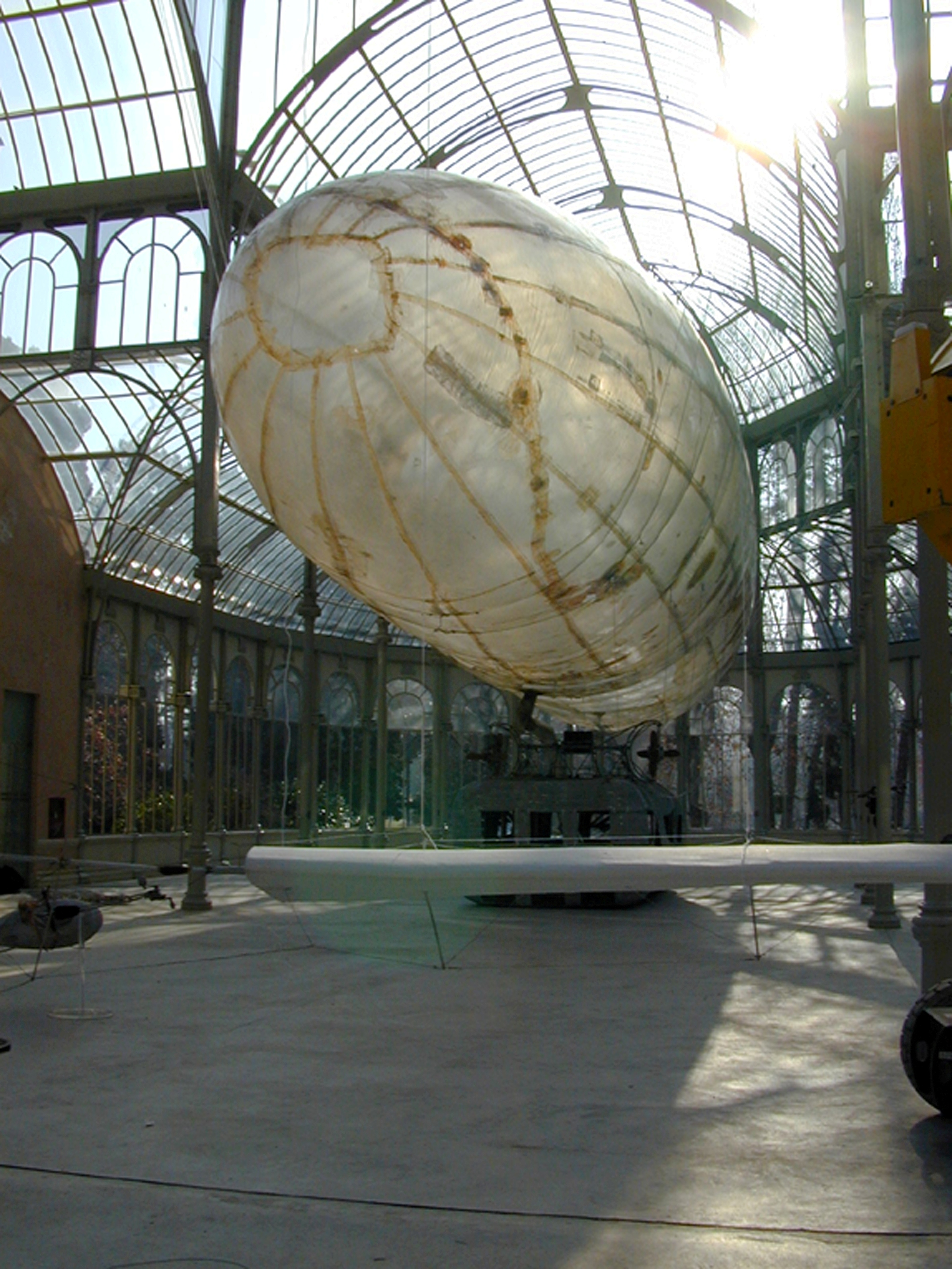 |
|
|
 |
|
History of the Aeromodeller (2006)
creator(s) S.M.A.K., Ghent
Panamarenko has a strong fascination for the methodology, the laws and the poetry of aviation. Since the mid-1960s, he has been developing ideas for producing his own aircraft. In the course of studying various structures and scientific theories relating to airships, the idea occurred to build a zeppelin. Panamarenko revealed the drafts for the airship balloon to the public for the first time at a happening in Antwerp in 1965. A few years later, the cultural centre A 379089 was established and the construction of the airship became the first ambitious project on the programme. In early 1970 Panamarenko started construction of The Aeromodeller on the basis of these draft studies and a thorough preliminary investigation. The studio-workshop was set up in the lower room of the cultural centre and construction was begun.
The first drawing was made in 1969, in which Panamarenko had already proposed a zeppelin with a transparent balloon and a cabin. Drawings exist with different proposals, however, such as one with the cabin in the balloon and one with two parallel balloons. Panamarenko issued a considerable amount of information on this artwork, including drawings, and he undertook an actual flight on an aerostatic balloon. Construction of ‘The Aeromodeller’ started in 1970.
The project was included in Sonsbeek buiten de Perken, a major art show held in the summer of 1971. During construction, the curator Wim Beeren closely followed the work. In the mean time, Panamarenko received messages from the Antwerp City Council prohibiting him from taking off in the Aeromodeller from Antwerp, along with several telegrams from the Arnhem authorities forbidding him to land in that city. On the initiative of artist Jef Geys, the experiment was carried out in a large meadow behind Geys’ home in Balen. Panamarenko camped there and set up the airship on location. The plan was for the airship to take off from Balen and land in the Sonsbeek Park in Arnhem.
On 26 June 1971, around 11 a.m., the experiment started. Normally, it would have taken about two hours to inflate the balloon with 650,000 litres of hydrogen gas. Scores of assistants pulled and dragged against the wind to get the balloon above the gondola. The cane gondola started deforming and tearing more and more with the passage of time. The fire danger had considerably increased. For reasons of safety, Panamarenko took a pair of scissors and cut a large tear in the balloon and the experiment turned into a countryside picnic. The balloon was not going to rise and the authorities in Arnhem could relax once again.
The event was recorded in a series of documentary films. The balloon was then put on exhibit during Documenta 5 (Kassel, 1972), where the balloon was fully inflated with air and presented as a work of art for the first time in an exhibition.
The Aeromodeller consists of three parts:
– a balloon (26.08 m length x 6.19 m diameter) made by adhering fifteen large pieces of polyvinyl chloride (PVC film, 0.350 mm thick) to each other using a synthetic rubber adhesive.
– a gondola made of cane, wood, textile and metal.
– a construction with servo-engine and propellers and gas tanks, all placed above the gondola.
The name: ‘The Aeromodeller 00-PL1’
The Aeromodeller was created between 1969 and 1971.The name was taken from an English language journal for model aeroplane builders. Some of the drawings are entitled Panamarenko 00.1LP or 00.1PL. 00.1 LP means eerste luchtschip Panamarenko or ‘first airship Panamarenko’.
Previous exhibitions of the Aeromodeller
2005 Koninklijk Museum voor Schone Kunsten, Brussels.
2002 Museo Nacional Centro de Arte Reina Sofia, Madrid.
2000 Bing of the Ferro Lusto, Hayward Gallery, London (catalogue)
1998 Panamarenko, The great flying saucer exhibition, Fondation Cartier, Paris, 11.4-31.5.1998.
1995 Museum van Schone Kunsten, Ghent.
1993 Maison de la Culture, Amiens.
1992-1993 Panamarenko. Tokyo, Osaka, Fukuyama, Toyama, Kamakura.
1991 Panamarenko. The Aeromodeller. Kunstverein Hannover, Germany, 11.10-24.12.1991.
1988 Collectie & Collecties. Georganiseerd door het Museum van Hedendaagse Kunst, Ghent, Floraliapaleis, 18.9-3.11.1988.
1988 Antwerpen. De jaren zestig hessenhuis, Antwerp.
1985 Panamarenko. Arbeiten 1966-1985. Kunstverein Friedrichshafen und Stadt Friedrichshafen, 10.10-10.11.1985.
1985 Dialogue sur l’art contemporain. Fundacâo Gulbenkian, Lisbon.
1982 Panamarenko. Haus der Kunst, Munich.
1981 Panamarenko. The Aeromodeller. Museè National d’Art Moderne, Centre National d’Art et de Culture Georges Pompidou, Paris, 13.2-4.5.1981.
1980 Kunst in Europa na ’68. Museum van Hedendaagse Kunst en Centrum voor Kunst en Cultuur, Ghent, 21.6-31.8.1980.
1978 Panamarenko. Nationalgalerie Berlin; Rijksmuseum Kröller-Müller, Otterlo; Vereniging voor Tentoonstellingen van het Paleis voor Schone Kunsten, Brussels.
1977 Panamarenko, Flugobjekte und Zeichnungen. Arnold Böcklin, Leonardo da Vinci, Wladimir Tatlin. Flugmodelle, pläne und fotos. Kunsthalle, Basel.
1972 -1975 Panamarenko spent a great deal of time in the Dutch town of Bergeyk to rebuild/ restore ‘The Aeromodeller’.
1972-1973 Panamarenko, automobile und flugmaschinen, Städtische Kunsthalle, Düsserldorf.
1972 Documenta V, Kassel, Germany.
1971 Sonsbeek buiten de perken. Park Sonsbeek, Arnheim.
English
 Attribution Non-commercial Attribution Non-commercial
|